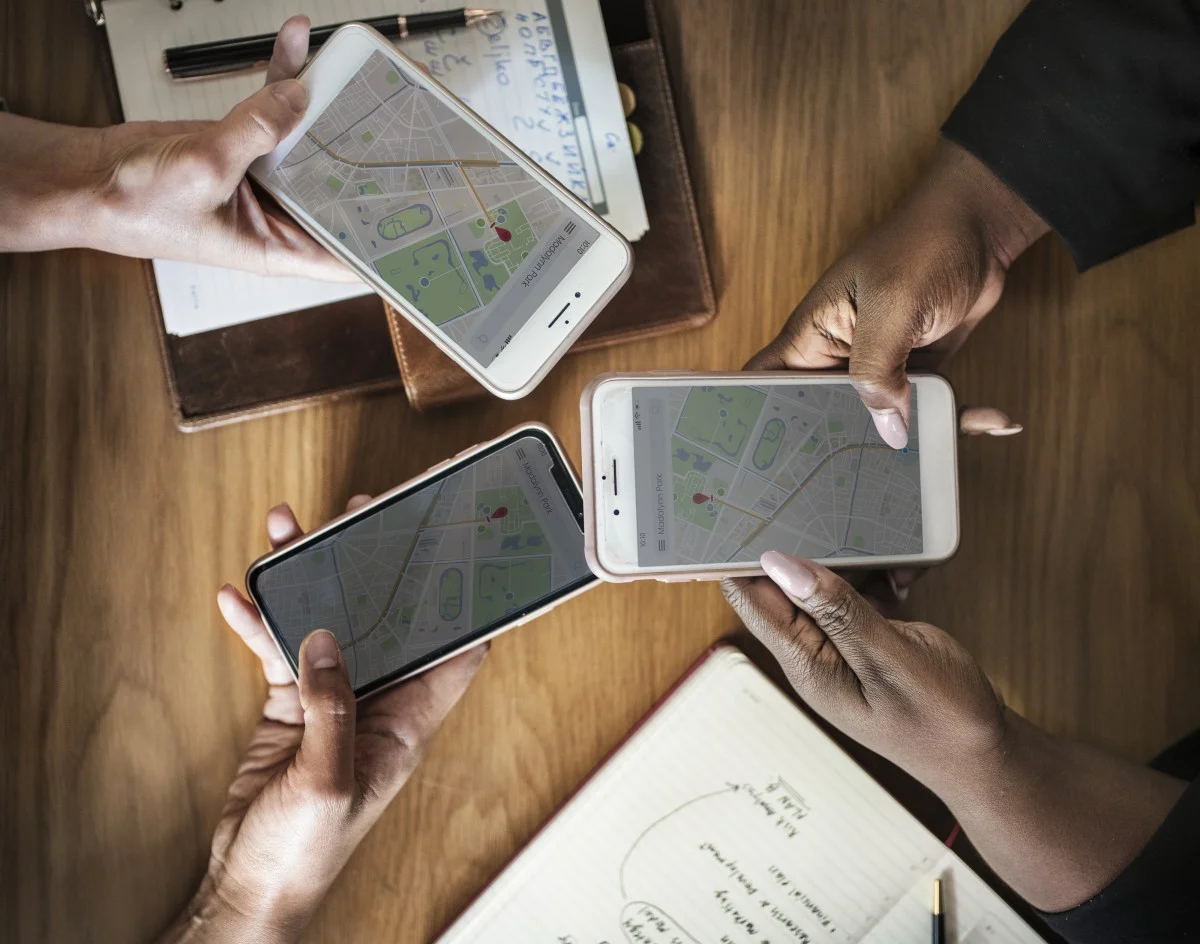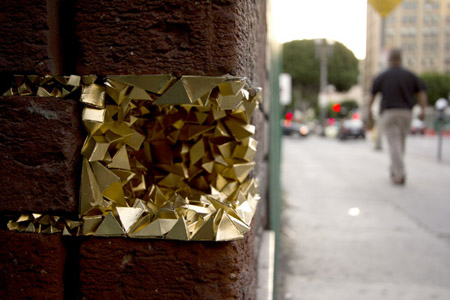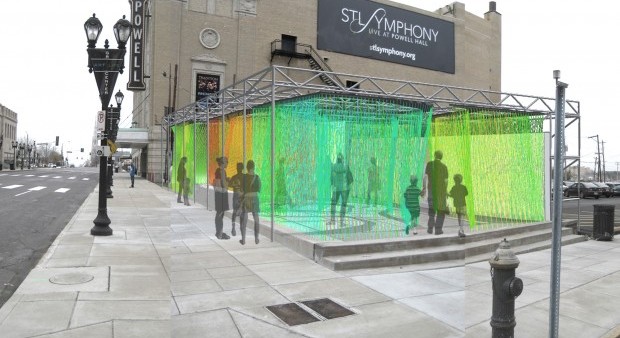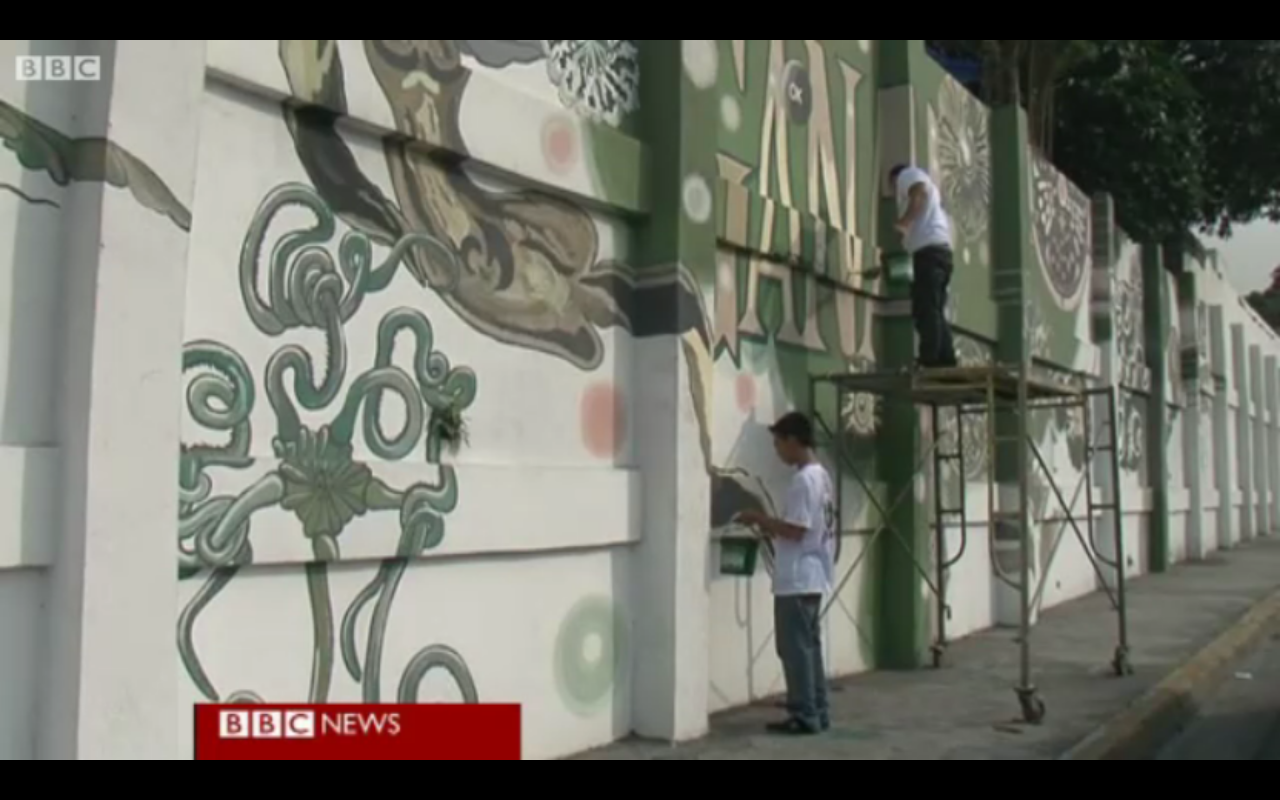In the context of a smart city, the goal is not simply to install digital interfaces in traditional infrastructure or streamline city operations, but rather to use technology and data in a purposeful manner to facilitate informed decision-making and enhance the overall quality of life. Public art has the potential to connect people to their city and to each other; as well as connect them to the experience of the art itself.
Build Interactivity into Public Art: Technology Interventions
One key element that differs public art from art produced for display in museums and galleries is that public art is often site-specific. It is critical to make public art more reflective of the place and community in which it resides through interactive and participatory approaches. How can technology contribute to the systems and interventions designed to drive public engagement?
Building Interactivity into Public Art
Do you think that interactivity can improve an audience’s relationship with public art? One key element that differs public art from art produced for display in museums and galleries is that public art is often site-specific, meaning it is created in response to the place and community in which it resides. Therefore, creating public art needs a certain level of customization to the physical local environment.
Connecting People to Place: How Digital Maps Advance Civic Engagement in the Cultural Sector
In a time where we can build and access a wealth of geographic information through our mobile devices and online, digital tools are being leveraged to make these kinds of civically engaged connections. Digital maps, in particular, have been built to service archival needs as well as transform the public’s interaction with art and archeological sites. By examining how organizations have deployed various digital map technologies in their work, we can also see how these tools have practical value and the potential to more broadly advance the cultural fields.
Physical and Digital Conservation Planning for Art in Exterior Spaces
One of the most challenging aspects of publicly exhibited works is their conservation, both in the physical and digital sense. One of the most challenging aspects of publicly exhibited works is their conservation. These works are often forced to directly withstand the elements, but also must be protected from graffiti and defacement. There have been examples of conservation issues forcing a public art office to remove an artwork, and Danielle Brazell from the Office of Cultural Affairs in LA described having to de-accession a work that could not be salvaged due to weather-related damage. The Cambridge Arts Council has worked to develop a streamlined system to mitigate problems with a pre-emptive strategy.
The Evolving Fusion of AR, Public Art, and Virtual Public Space
Public art in commercial and recreational structures is a means to bring communities together and directly connect people with the physical space around them. Typically, public art is presented in the form of murals, sculptures, architecture, and environmental art. In addition to social bridging, public artworks can serve as identity-markers for particular locations, mediums to express distinct points of view, and vehicles to inspire personal and social change.
Is a Digital Map in Your Organization’s Future?
Online Tools for Artists & Audiences: A Case Study of the Pittsburgh Artist Registry and Pittsburgh Art Places
2013 was a busy year for the Office of Public Art (OPA) here in Pittsburgh. Along with its regular duties of programming public art walking tours, organizing calls for entries, and facilitating webinars and artist lectures, OPA also re-edited its book Pittsburgh Art in Public Places, revamped the Pittsburgh Artist Registry, and created the Pittsburgh Art Places website.
The following article analyzes how this organization, a public-private partnership between the Greater Pittsburgh Arts Council and the City of Pittsburgh Department of City Planning, made management decisions that led to the update of the online artist registry and creation of Pittsburgh Art Places.
Cross-Sector Partnerships in the Arts: Fendi and the Trevi Fountain
At a press conference on Monday, Fendi designers announced the fashion house will finance the restoration of two fountains in Rome, the 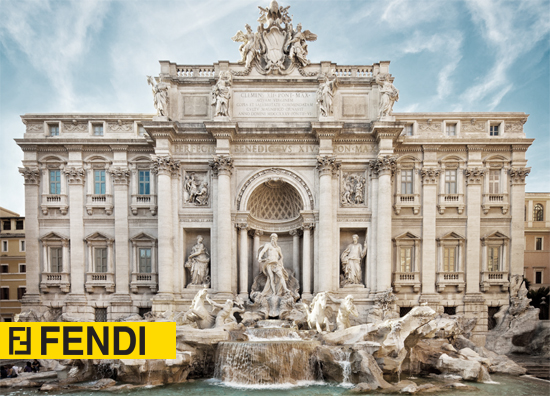 Quattro Fontane and the iconic Fontana di Trevi, or Trevi Fountain (built between 1732 and 1762). The US$2.9 million (€2.18 million), 20-month project will be completed in phases, as explained by Fendi designers Karl Lagerfeld and Silvia Venturini Fendi. These phases will include the re-waterproofing of the main basin, the cleaning of the façade and marble statues, and restoration of the gilded inscriptions. The Trevi Fountain will remain open to tourists throughout the restoration process (fear not tourists, fear not).
This announcement comes at a time when the funding for and preservation of cultural heritage sites in Italy is uncertain. Fendi, however, is not the first big-brand fashion name to take action in the preservation of Italy’s cultural heritage. Tod’s, an Italian company producing leather shoes and bags, is currently financing the restoration of the Coliseum for US$34 million (€25 million). Further north in Venice, Diesel, an Italian fashion company, is funding the restoration of the Rialto Bridge for US$6.7 million (€5 million).
Quattro Fontane and the iconic Fontana di Trevi, or Trevi Fountain (built between 1732 and 1762). The US$2.9 million (€2.18 million), 20-month project will be completed in phases, as explained by Fendi designers Karl Lagerfeld and Silvia Venturini Fendi. These phases will include the re-waterproofing of the main basin, the cleaning of the façade and marble statues, and restoration of the gilded inscriptions. The Trevi Fountain will remain open to tourists throughout the restoration process (fear not tourists, fear not).
This announcement comes at a time when the funding for and preservation of cultural heritage sites in Italy is uncertain. Fendi, however, is not the first big-brand fashion name to take action in the preservation of Italy’s cultural heritage. Tod’s, an Italian company producing leather shoes and bags, is currently financing the restoration of the Coliseum for US$34 million (€25 million). Further north in Venice, Diesel, an Italian fashion company, is funding the restoration of the Rialto Bridge for US$6.7 million (€5 million).
Of course, these generous donations do not go without recognition. For Tod’s, the funding agreement provides the company the rights to the Coliseum’s logo for 15 years, as well as branding Coliseum tickets with the company logo. Fendi’s sponsorship of Rome’s grandest fountain will be recognized by a small plaque to be placed near the fountain for four years.
The city council and Mayor Gianni Alemanno of Rome are hopeful these interventions will continue, as the preservation of the country’s past is in peril. Alemanno said, “Without similar initiatives, we won’t be able to save the cultural memory of our country.” Though council members are supportive of the private sector’s involvement in the preservation of Italy’s cultural heritage, some conservators are wary. They fear private-public partnerships will commercialize monuments of national pride, turning sites of inherent meaning and cultural significance into fashion advertisements.
The private-public partnership between Fendi and the Trevi Fountain is just one of many examples of a paradigm shift in the cultural sector regarding what Alemanno says is, “a new system of cultural patronage.”
Beautifying the City through Public Works of Art
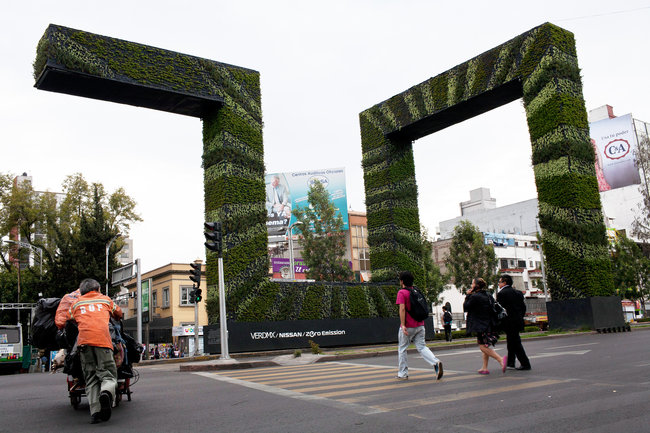 There may be no better way to beautify a city (or most cost effective way, in many aspects) than by using public works of art.
As I have written about before, cities, especially cities that are losing population and/or facing severe budget shortfalls, are turning more and more to public art to revitalize areas and encourage more tourism. And as I wrote about last week, cities are turning more and more to what makes them unique, a significant change in focus from the tried and true method of trying to outdo or outclass your neighbors. Gone are the days (I hope, at least) of cities competing for visitors by building bigger stadiums or concert halls in an attempt to prove that they are, in fact, the most exciting city this world has ever seen.
There may be no better way to beautify a city (or most cost effective way, in many aspects) than by using public works of art.
As I have written about before, cities, especially cities that are losing population and/or facing severe budget shortfalls, are turning more and more to public art to revitalize areas and encourage more tourism. And as I wrote about last week, cities are turning more and more to what makes them unique, a significant change in focus from the tried and true method of trying to outdo or outclass your neighbors. Gone are the days (I hope, at least) of cities competing for visitors by building bigger stadiums or concert halls in an attempt to prove that they are, in fact, the most exciting city this world has ever seen.
In light of all this talk about urban renewal, green spaces, and new works of public art, what are some of the latest and greatest pieces of work on display? A number of outlets, including the New York Times, the Atlantic and others, have recently taken a look at works from across the world, and I have assembled them here for your viewing pleasure!
The New York Times recently took a look at a new project in Mexico City that seeks to provide both aesthetic pleasure and help the environment: a set of three “eco-sculptures” that comprise a sort of urban garden in the city. As you can see in the image above, these arches, comprised of thousands of plants each, are an attempt to beautify the city and help ease pollution in the large metropolis. Installed by a local non-profit, the sculptures are part of an overall effort to help green a city that is not particularly known for having a sustainable reputation; as the New York Times reports, these three sculptures are just a small part of a broader garden movement, and the attention these works of art have received are bound to make the effort that much more noticeable.
Over in Los Angeles, a new public art project has taken a little of bit of nature and transported it, visually at least, to an urban area. Artist Paige Smith has crafted little miniature geodes, crystals that form inside of some rocks, and installed them in unassuming places around the city: inside pipes, brick walls, or even the cracks of a wall. Smith has created little 3D sculptures made of paper to have the appearance of geodes, and the result is a unique little diversion from the normal city wall. She’s up to a dozen installations across the city, and you can see a full map of locations on her website.
(Photo courtesy of Paige Smith)
In St. Louis, public art is being used to help solve a problem: how do theatres make their patrons more efficient? In other words, is there a way to encourage patrons to stay longer and keep themselves busy, instead of just standing around waiting for the show to start?
A piece is going up in the Grand Center neighborhood of St. Louis that is designed to encourage patrons and visitors to stay a while. Titled “A Chromatic Confluence,” it will be a mazelike sculpture made up of about 20,000 feet of different colors of string. The overall structure will be fairly large in size, about 25-feet by 65-feet, and will be lit up at night, as you can see below. Hoping to draw in patrons and foot traffic, it is an attempt to grab people’s attention and give them something to do before the show starts. The piece is the first of a planned series of public art projects in the St. Louis area, in an overall attempt to bring more culture and artistic pieces to the city.
(Photo courtesy of the St. Louis Post-Dispatch)
Overseas, the city of Manila is moving ahead with public art, but is doing so in an attempt to be as environmentally sustainable as possible. Manila has the distinction of being one of the world’s most polluted cities, and attempts have been made in recent years to help cut down on emissions and improve air quality.
Courtesy of the Atlantic, a local Philippine company has created a paint which it claims can help purify the air while being used, and since the discovery, murals have been painted all over the city in attempt to not only beautify areas of the city that been victims of neglect and destruction, but also help the environment as well. The BBC recently filed a report about the paint and the attempt to improve the city through public art.
(Photo courtesy of The Atlantic)
These are just a few of the examples of cities using public art to help improve the aesthetic quality of their cities. Many more projects are underway, popping up in cities all across the United States and the world. What are some of your favorite public works of art in your cities, or perhaps favorites you’ve seen in others? Feel free to comment below!
(Top photo courtesy of the New York Times)
Public Works of Art Face New Challenges
When looking at the great cities of America and the world, one of the things that give these places the kind of culture and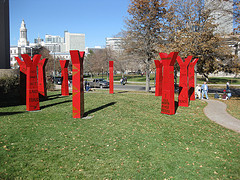 character they are often known for is public works of art. These exhibits, often unique and memorable, provide a focal point for tourists and a sense of civic pride for residents.
However, in these tough economic times, a new problem has emerged for cities everywhere: with cities struggling financially, these works of art are suffering from neglect, acts of vandalism and normal wear and tear, and often do not have the funds necessary to properly maintain them.
character they are often known for is public works of art. These exhibits, often unique and memorable, provide a focal point for tourists and a sense of civic pride for residents.
However, in these tough economic times, a new problem has emerged for cities everywhere: with cities struggling financially, these works of art are suffering from neglect, acts of vandalism and normal wear and tear, and often do not have the funds necessary to properly maintain them.
These kinds of problems are being felt in cities all across the country. In my hometown of Phoenix, a story last month in the Arizona Republic highlighted the struggle that cities are facing: public works of art are more popular than ever, but face neglect and lack of upkeep due to budget shortfalls and calls for budget austerity.
The problems associated with the upkeep of public works of art go beyond the usual wear and tear: vandalism, including graffiti, is common, along with the theft of metals and gems that are often a part of some displays. The cost to maintain and replace these works of art, especially older exhibits, can prove costly. In a citywide audit, the city of Phoenix found that dozens of public art pieces were in need of repairs, with the total renovation costs estimated to be over $1 million. While most projects were victims of vandalism or wear and tear, others experienced some unexpected problems: for example, an overpass exhibit needed almost $100,000 in repairs because of runoff water eroding parts of the project.
In November, I wrote about how public works of art were more important than ever in today’s climate of budget austerity, and the continued vandalism and destruction of these art displays adds another layer of difficulty when it comes to saving exhibits. While the upfront cost of public art displays often receive the lion’s share of attention and public outcry, the cost of vandalism and neglect often go unmentioned. The costs associated with restoration can ultimately have another impact as well: cities often have to cancel funding for new art projects to care for existing pieces badly in need of repair.
With cities facing decreased tax collections in recent years, the money to help maintain and preserve public works of art is severely lacking. Some cities, including those in the Phoenix metropolitan area, require a certain percentage of money from construction projects be devoted to public art, which in robust economic times provides a stable source of revenue for new art construction and upkeep. The problem, however, is that during tough economic times, less construction projects are taking place, which means that the funding for public art dries up. In a state like Arizona, which was devastated by the housing bubble, the impact can be quite substantial. As the Arizona Republic reported, the difference in funding levels can be quite severe: in the city of Phoenix, the budget for maintenance and restoration went from $63,000 in 2008-09 to just $29,000 in 2011-12. The problem was even more severe in Tempe, home to Arizona State University: the budget went from $90,000 in 2008-09 to just under $8,000 in 2011-12.
So with city funding for upkeep and restoration limited in these tough economic times, what kinds of solutions are available to save public works of art? One option is to raise money through increased taxes; while tax increases are often unpopular, they could be levied in such a way that the impact would be negligible on residents. Examples could include taxes on travel expenses, like car rentals and hotels, or on city services like utility bills. Another option is for cities to seek grants from non-profit and private sources; while most cities seek private funds to sponsor new works of art, efforts to help beautify existing works of art can help promote civic pride and improve areas already in use.
And while they certainly have access to more capital and resources, cities and local governments are not the only people that can have an impact. Residents and community groups are often getting involved as well; helping to “sponsor” an exhibit can often have just as much of an impact. By painting over graffiti, picking up waste or helping to raise money for upkeep, ordinary citizens can promote and protect their community’s works of art. As more and more pieces face neglect and vandalism, residents often feel the urge to protect the town they call home.
Public art projects often serve as a way to remind residents and visitors alike of the culture and history of that particular place. In these tough economic times, these exhibits and projects are in danger of being neglected entirely, damaging not only the art itself, but also the civic pride of residents all across the country.
(Photo: CC by Mal Booth)
Public Policy Through the Eyes of Artists
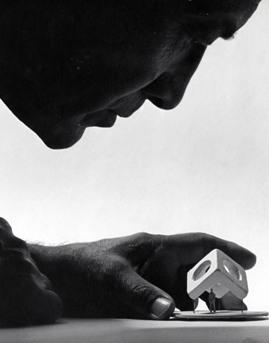 In the world of public policy, ideas are a dime a dozen. From issues ranging from education to trade issues, everyone has their opinion about the best course of action the government should take. What’s often missing, however, are new and exciting ways to present these ideas, taking formally bland issues and finding new ways to solve them.
This is where the arts community comes in.
In the world of public policy, ideas are a dime a dozen. From issues ranging from education to trade issues, everyone has their opinion about the best course of action the government should take. What’s often missing, however, are new and exciting ways to present these ideas, taking formally bland issues and finding new ways to solve them.
This is where the arts community comes in.
While city planning and urban development may not be the most exciting issues to talk about, an exhibit in New York City is showcasing four artists who are attempting to use the power of artistic expression to bring attention to urban planning issues that are present in their communities. By offering a unique way of examining these often complicated public policy issues, the hope is that visitors will leave with a heightened sense of the issues that are affecting their community.
The exhibition, “Civic Action: A Vision for Long Island City,” opened on October 13th of this year and continues until April 22, 2012 at the Noguchi Museum and Socrates Sculpture Park in the Long Island City community of Queens, New York. The exhibit has received a fair amount of press attention, including a great write-up in The New York Times last week.
There have been similar art exhibits where policy ideas are presented by artists themselves, who often have no connection to the policy community or stakeholders. What’s unique about this project is that the four artists involved where all invited to partner with an urban planner or architect to imagine and conceive new developments in the Long Island City area, bringing a degree of realism and practicality to the individual projects. Instead of imagining idealistic public spaces or infrastructure improvements, the artists were advised to come up with ideas for spaces that would compliment already existing structures.
The ideas range from practical to the more unrealistic. The four artists featured in the exhibit are Natalie Jeremijenko, Mary Miss, Rirkrit Tiravanija and George Trakas.
Jeremijenko’s exhibit, titled “UP_2_U,” combines the worlds of art and technology (something we love!) and offers some unique ideas of her own. The exhibit includes robots, computer components and more simplistic things as do-it-yourself fixes to become more sustainable. The crux of the exhibit involves asking visitors to take more action to improve the communities around them; as a play off the title, she tells visitors it is “UP 2 U” to bring about the change you’d like to see.
Mary Miss’s exhibit includes a “City as a Laboratory,” where artists, policy makers and stakeholders come together to solve complicated policy problems. Another installation, titled “If Only the City Could Speak,” includes large visual thought bubbles containing ideas and policy ideas for the community. The larger tone of her exhibit invites a sense of participation engagement and encouragement for visitors to get involved in their community. One of the proposals in her exhibit concerns a local issue: four smokestacks that dominate the skyline of the Long Island City community. She proposes to turn the stacks into a kind of environmental sustainability center that creates long-lasting environmental improvements for the area.
My favorite area of the exhibit comes from Tiravanija, who among his proposals includes an idea for a section of Broadway: growing drivable grass. Yes, you read that right. Not all of his ideas are that outside-the-box, however; another favorite is more practical and involves building a community kitchen in the area.
Finally, Trakas’s work involves an area that urban planners and architects around the world have embraced more and more over the years: waterfront development. Naturally, as an artist, Trakas is less concerned with creating stores and condo complexes and stadiums on the waterfront; instead, he envisions a waterfront area as a place where residents can learn more about the community’s history through exhibits and public information. The idea is creating a public space that is less commercial and more about the community itself.
Throughout all four exhibits, the greater message seems to be that the intent is to start a conversation about the future development of the Long Island City area. What types of planning ideas should be implemented? What approaches should local government officials take to complicated public policy questions? While the artists and those involved in the exhibits may not have all the right answers, the exhibit itself is a refreshing reminder that sometimes the best policy ideas do not come from government offices or elected officials: sometimes, the best and most original ideas come from those who are active in their communities, aware of local issues and problems, and passionate enough to devote time to the issues. In this case, that category just so happens to include the arts community.
Twitter as a Performance Art Platform
Social Media Spotlight: Crowdsourcing Archives with Richard McCoy
Welcome to the sixth installment of the Social Media Spotlight, our monthly feature focusing on arts organizations’ social media strategies.
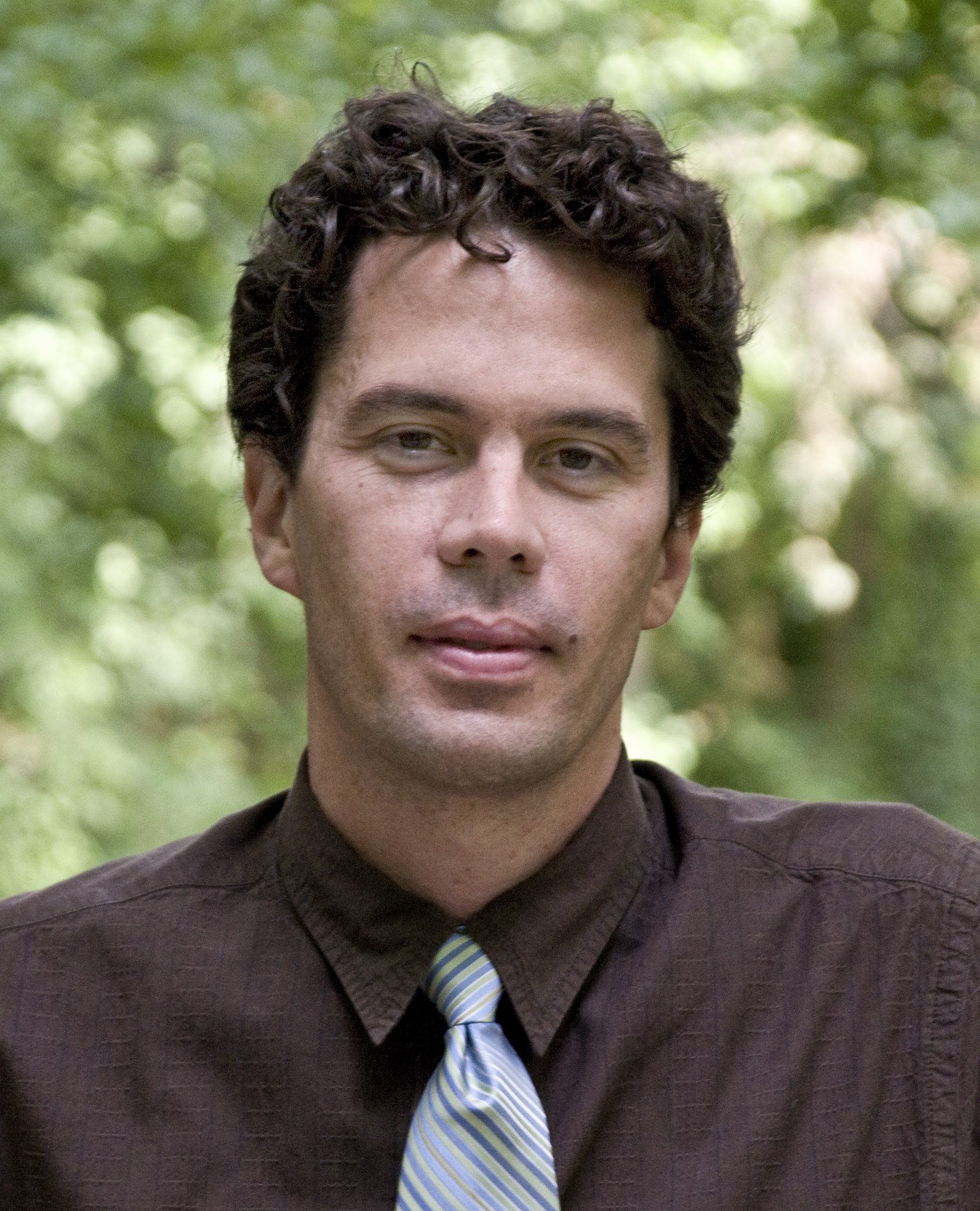 Making the arts a more participatory experience is an exciting idea being developed by many arts organizations across the globe. Visitors to some institutions can now digitally tag artwork with their own unique descriptions or add photos of themselves to a community Flickr pool. Taking the role of participation even further, some organizations are turning to crowdsourcing, inviting the audience to help in the creation and documentation of art.
Making the arts a more participatory experience is an exciting idea being developed by many arts organizations across the globe. Visitors to some institutions can now digitally tag artwork with their own unique descriptions or add photos of themselves to a community Flickr pool. Taking the role of participation even further, some organizations are turning to crowdsourcing, inviting the audience to help in the creation and documentation of art.
I recently had a chance to chat with Richard McCoy, Associate Conservator of Objects & Variable Art at the Indianapolis Museum of Art, about his use of crowdsourcing and public access tools to get the public involved in documenting public art.
I
How did you get interested in documenting artwork online?
By 2008 basic versions of all of the tools that cultural institutions use to create, store, and share documentation about their artworks were freely available online (Wikipedia, Flickr, and YouTube), so I’d say my interest really got serious around this time. I know it’s a bit nerdy, but I keep a pretty good record of my interests in documenting artworks online over on my Wikipedia User Page. My basic thought was why not do it? The investment is low and the potential for return is enormous.
I
Why involve the public in the process?
To properly care for an artwork you have to care about an artwork; you have to recognize its existence within your community. Many public artworks on display around the world are overlooked, their context and meaning forgotten on daily basis. So to have the public involved is an important aspect of this project. The more people that are involved in caring about and for public art and helping to document it, the better.
I think Clay Shirky has done a good job over the years explaining how the participatory web is radically different from our traditional notion of information sharing and collaboration. His 2005 Ted Talk is still ahead of its time. I agree with him in that we are just waking up to the notion of a large-scale participatory process that involves broad audiences using their “cognitive surplus” productively.
My interest has been more in community than public, though. Documenting public art should be a community effort. While it’s not the easiest thing to do, it’s a process that we have taught and developed with more than 40 IUPUI students.
We’re at a point where we can begin seeing that this is a project that should be operating on a global scale. Right now there could be folks documenting a mural in L.A. and a small town in India.
I
Where did the choice to use wikipedia as a teaching tool come from?
I first started using Wikipedia as a teaching tool in the fall of 2009 when professor Jennifer Mikulay invited me to co-teach an IUPUI Museum Studies Program graduate-level course, Collections Care and Management.
We created a project for our class to document all of artworks on and around IUPUI’s campus. That semester our students created 42 new Wikipedia articles and uploaded 375 new images of the IUPUI artworks into Flickr. The result culminated in the creation of the IUPUI Public Art Collection and the beginning of WikiProject Public Art, which was first called Wikipedia Saves Public Art.
This year I taught the course by myself. I used WikiProject Public Art as a final project to document the artworks inside and around in the Indiana State House. My students made 37 new Wikipedia articles and uploaded 272 images into Flickr. We did all of the work within the confines of Wikipedia. My hope was to model a project that could and should be repeated all over the country.
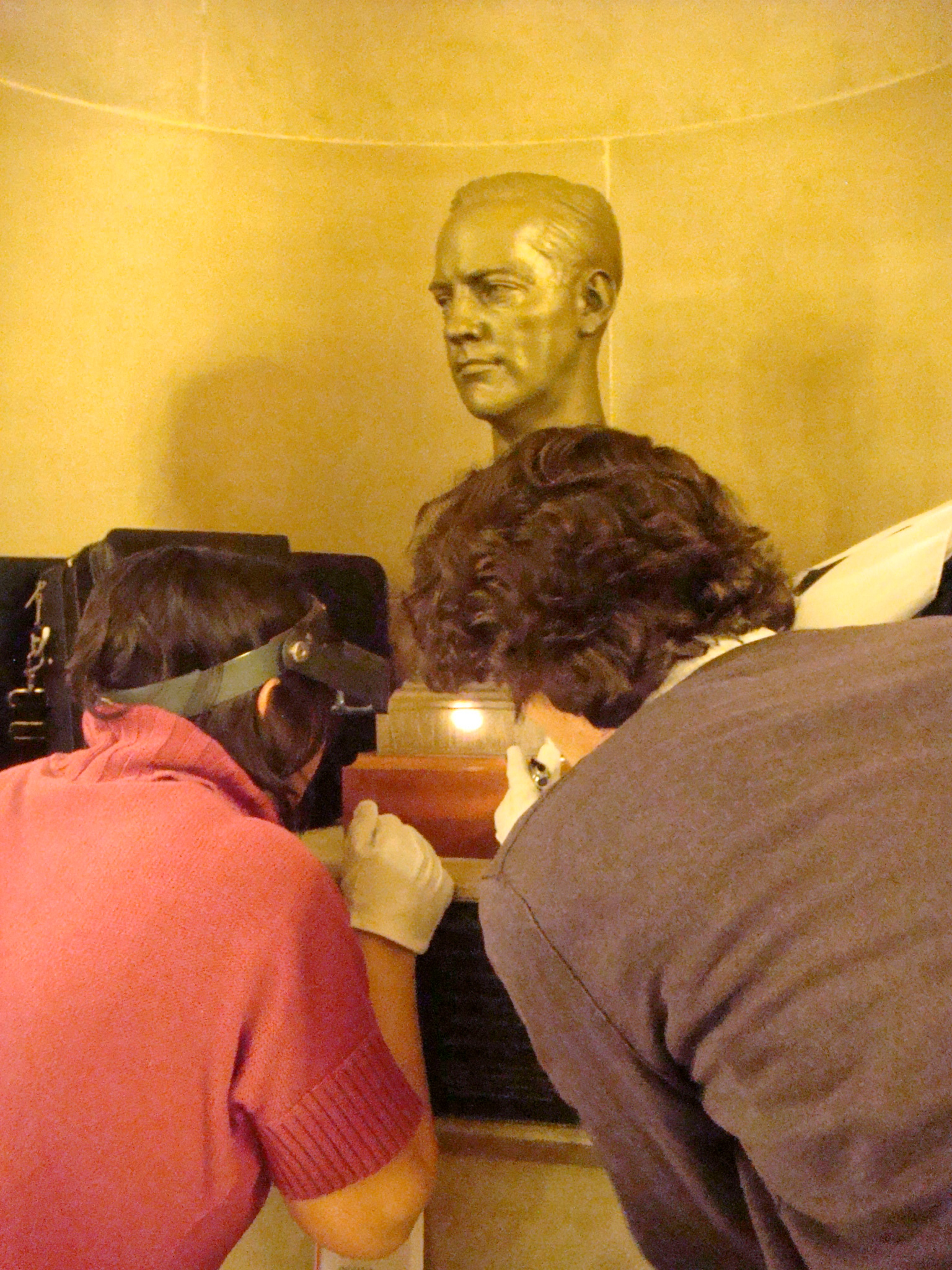
In addition to creating the Indiana State House Public Art Collection, I assembled all of the articles into in an easy-to-download book. I wrote a summary of all of this documentation work in the article New Systems for Documenting Public Art on Liam Wyatt’s blog.
I
I understand you and the class were recently recognized by the State of Indiana for this work. What was that like?
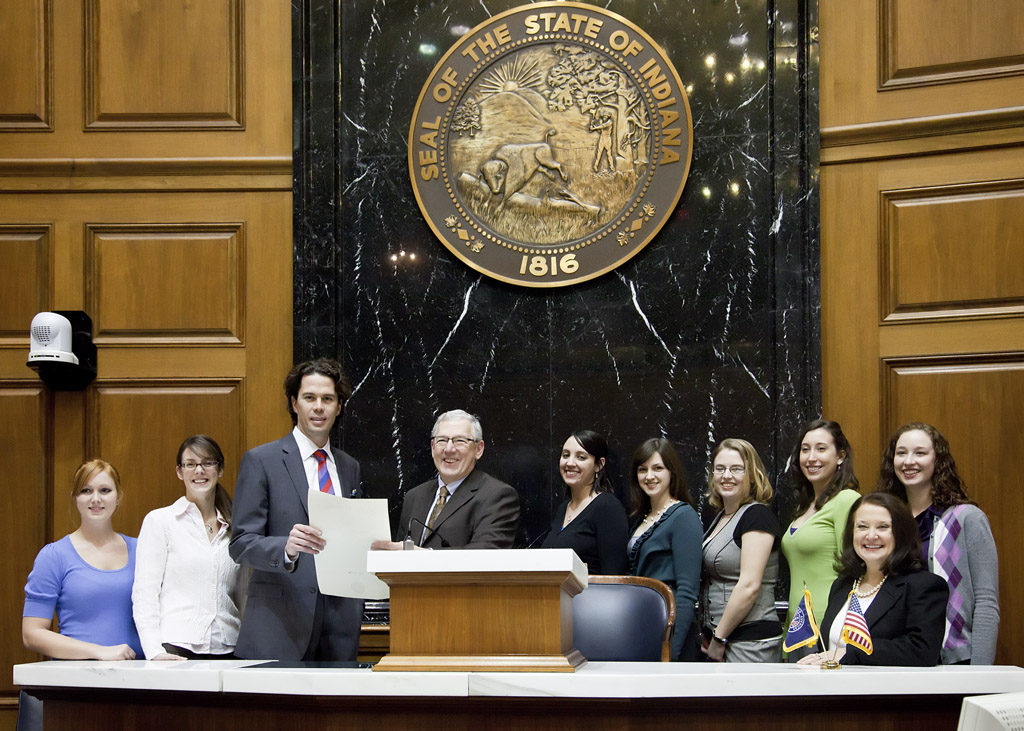
We were tremendously honored to have both the House of Representatives and the Senate of the State of Indiana recognize our work with Concurrent Resolutions. I’m most pleased about this recognition because it furthers the mission of the project: to raise awareness about the artworks at the Indiana Statehouse.
While this recognition can be personally gratifying, the project is designed with the hope that the students will take ownership of it and its outcomes, as they are the ones who did the lion’s share of the documentation.
I
Can you talk about the Public Art Documenter Project? How does it work and what are your goals for the project?
For a long time, I’ve wanted a mobile app that would allow for the easy documentation of public art. The most basic component of any kind of documentation involved three components: location, photography, and the basic tombstone information about an artwork. This would seem fairly easy to do with a mobile app.
Image via appbrain.com
When I found the mobile app creator, EpiCollect, which was developed at the Imperial College London, I was pretty excited. With this tool I was able to quickly make the Public Art Documenter. There are some down sides to this app, mainly in that it was developed with Google Apps, so it works really well on Droid phones, but not so well on the iPhone. It’s also pretty tech-heavy, so it’s not all that easy to use. I’ve been in conversation with the folks at Imperial College London who are in the process of creating the next version of this app which apparently will improve a lot of the iPhone bugs.
Also, with a number of friends, I’ve experimented with the potential for location-based applications such as Gowalla and Foursquare to serve this function. With Gowalla, I’ve made a couple of “Trips” including the “Top 10 Public Artworks in Indianapolis” (http://gowalla.com/trips/557).
I
I
I
Was there a specific reason you chose not to go through process of building an app of your own?
We’re really in an experimental stage with a mobile app. We’ve considered applying for grants to develop and expand the project, including creating a mobile app. But more than money, what the project really needs is a few institutional partners that are interested in using current technologies to document public art, or artworks in general. While we’ve explored this with what would appear to be a few natural partners, including the Smithsonian Institution, who holds the archives for the important project Save Outdoor Sculpture!, we’ve yet to get anyone to directly support any aspect of the prospect.
I
Crowd-sourcing archives is an exciting idea, but I can see some people arguing that it cannot compare to traditional documentation methods. How do you view your projects fitting in with current and past archival and documentation techniques?
This is a really interesting point to consider, and it goes not only to the storage of information, but the ownership of information and data. When you work in Wikipedia you are applying a Creative Commons license to the information you create. Also you are working collaboratively with a shared goal in a system that can be updated instantly by anyone in the world. Because the information is built with this structure, it’s then actually owned by everyone and really no one. This is a fantastic notion to consider vis-a-vis traditional documentation and sharing methods.
For example, compare our project to Philadelphia’s MuralFarm.org, Indianapolis’ Public Art Locator, or the Save Outdoor Sculpture! data. While this is all good data and information about public art, it’s stuck behind a website that is controlled by a very small handful of people. All of these systems were designed to increase access to information about public art, but none are able to offer the kind of inclusion that’s possible with Wikipedia.
Plus in using Wikipedia you are actually invited to download the whole data set and keep it for yourself. In fact, the information is licensed such that if you wanted to, you could use their book creator tool (the one I used to make the book about the Indiana State House Public Art Collection), create a book and then sell it for a profit, or just print it and have it on hand. This is what the State House did with our information, so now they have the most complete records of their artworks in the more than 100 year history of the State House.
I
Your projects all focus on primarily documenting public art, do you see these ideas and methods working well for other areas of the arts?
Of course! I recently had an intern working for me at the museum that developed an e-volunteer program that invites people to create Wikipedia articles about artworks in cultural instituions. While we have a pilot underway at the IMA, we hope that other cultural institutions follow suit and invite their patrons to help document their collections.
Not only do many institutions lack the resources to basically document their collections, but few have recognized the value of incorporating a participatory audiences in the process.
The lack of cultural institutions with decently documented collections was famously spelled out in the Heritage Health Index Results, and reinforced in the 2009 Salzburg Global Seminar, “Connecting to the World’s Collections: Making the Case for Conservation and Preservation of our Cultural Heritage”, but few have recognized the need to open the doors and encourage a broad spectrum of participation.
Future Focus: The Public Art Archive
 Sharing information and digital media about public art has never been an easy task for arts administrators. The Western States Arts Federation (WESTAF) seeks to change that when they launch the Public Art Archive - an online, searchable database for public art in the United States. A tool for both arts administrators and the general public, WESTAF’s vision is for the Archive to serve as an easy to use, central source of information about public art. I recently had a chance to speak with the creators of the Public Art Archive and take a guided tour through the site.
Sharing information and digital media about public art has never been an easy task for arts administrators. The Western States Arts Federation (WESTAF) seeks to change that when they launch the Public Art Archive - an online, searchable database for public art in the United States. A tool for both arts administrators and the general public, WESTAF’s vision is for the Archive to serve as an easy to use, central source of information about public art. I recently had a chance to speak with the creators of the Public Art Archive and take a guided tour through the site.
The Public Art Archive has a straightforward, user-friendly interface. Entry to the Archive takes place through a simple search bar on the front page, powered by Solr, an open-source search platform from by the Apache Lucene project. You may already be familiar with Solr, as it is the search engine used by both Etsy.com and FoodNetwork.com.
Solr allows you to refine simple searches on the Archive through multiple filters with a variety of search criteria such as artist, location, materials, collections and even nicknames. The search criteria and vocabulary for the site was built from the same standards as those used by reference websites like ARTstor and the digital library projects at Harvard.
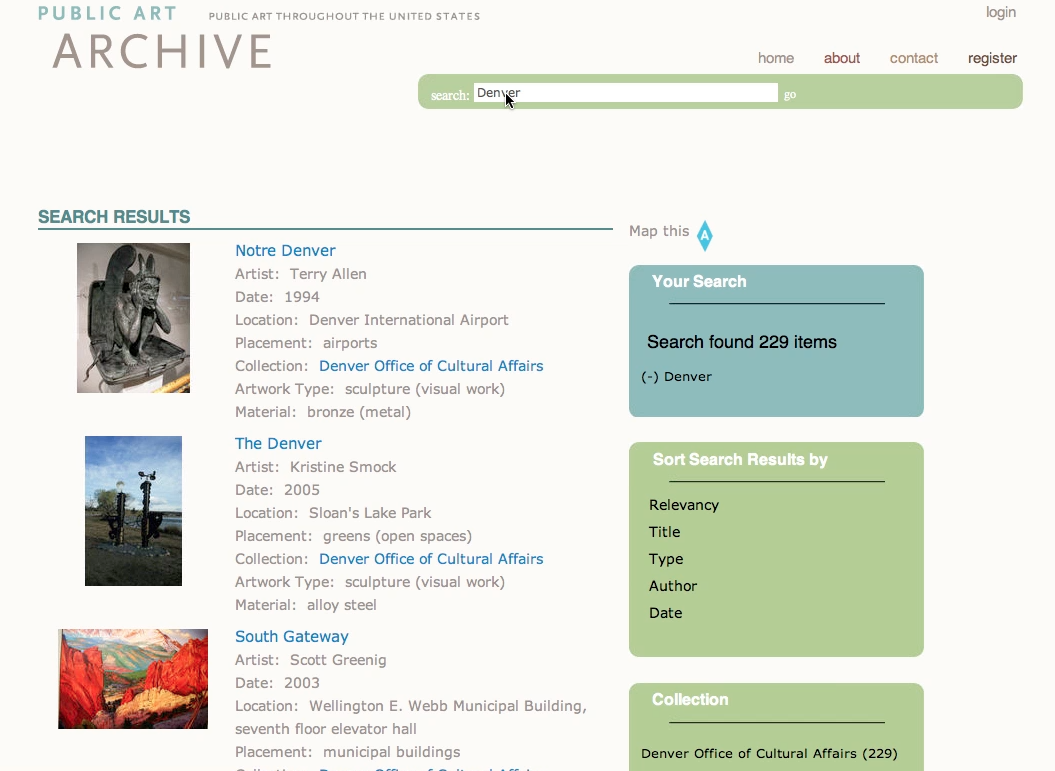
Once they’ve found the artwork they are searching for, users are presented with a variety of information and media about the work. In addition to the artwork’s basic info, users can view pictures and video, download PDFs about the artwork, and listen to audio describing the piece.
While the capability for all this content is built in, individual administrators must submit all information and media for each artwork. The Archive has no limit on the amount of content that can be submitted for each work and submission of the content is free. At a minimum, the site requires a full description for each work, as well as its location, and one high quality image.
To enable use of the Archive when an individual is physically in front of a work of public art, the Archive will be accessible from any web-enabled mobile device. No specific apps will be required, users just plug the main url for the Archive into their phone's web browser to access the full functionality of the site.
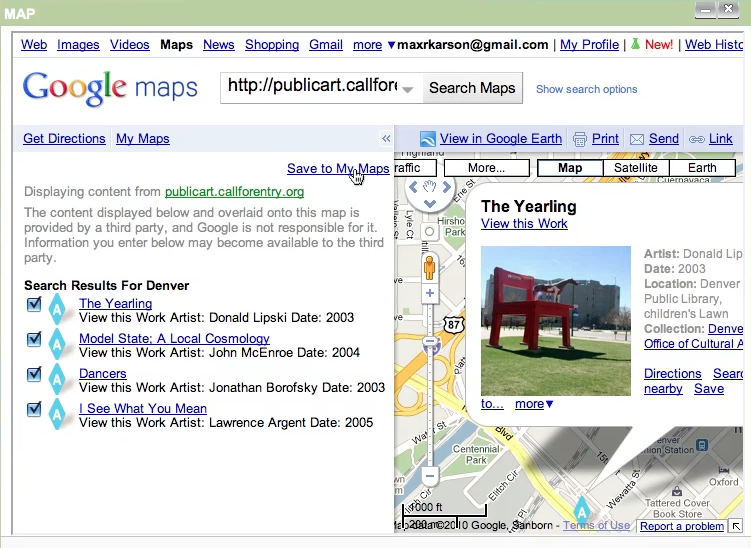
The Public Art Archive will also be fully integrated with Google Maps. By clicking the site’s “Map This” icon, users will be able to view exactly where the artworks are located and build custom maps of artworks that can be shared with others or saved for later use. Administrators can use the mapping function to create custom maps for use in tours of their collection, maintenance tasks, and advocacy initiatives.
The ability for organizations to create personalized pages so they can maintain their identity will be added as the Archive progresses. WESTAF also plans to have licenses available to give organizations access to the more administrative functions of the Archive.
The Public Art Archive will be launching in the near future, but until then visit westaf.org to check out some of WESTAF's other projects that offer technological solutions for arts administrators.












